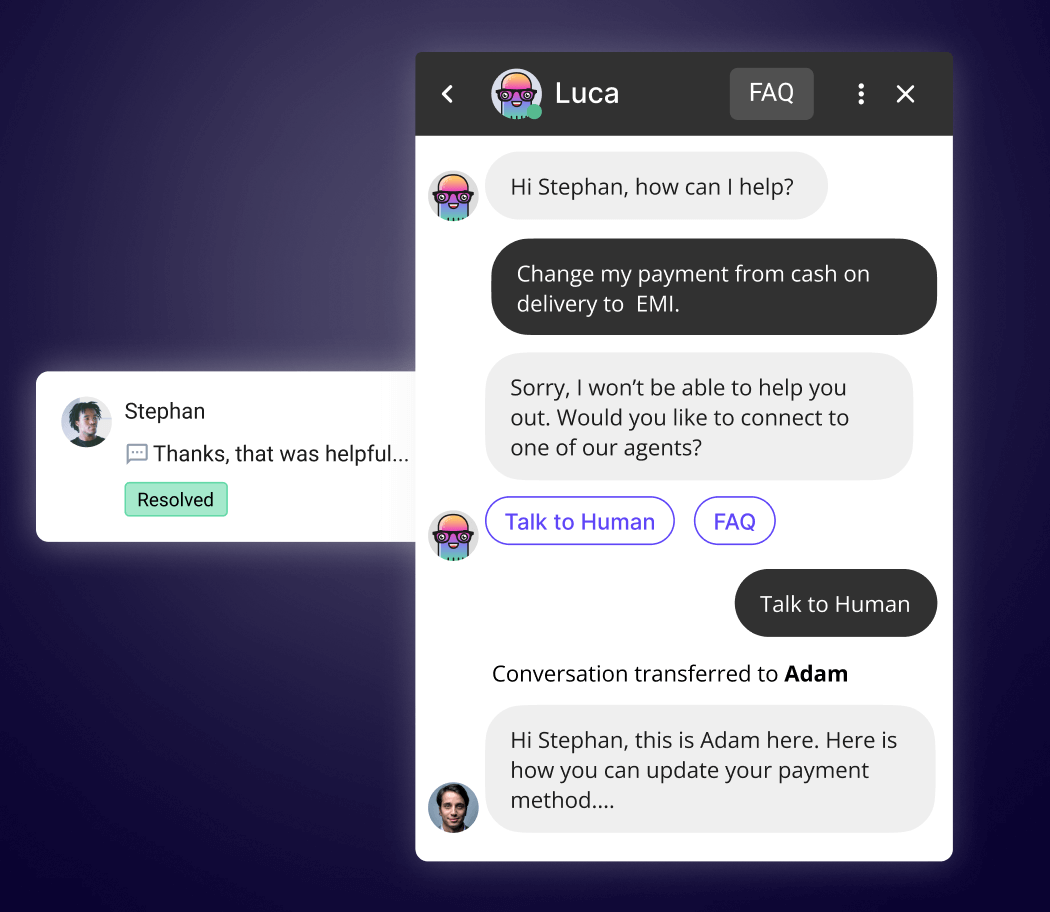In the world of automated customer service, chatbots play a crucial role in handling customer inquiries efficiently. However, not all issues can be resolved by a chatbot. This is where human handoff comes in— a crucial process where the chatbot transfers the conversation to a human agent. This transition is vital for complex problems that require personalized attention, ensuring that customers get the help they need when automation falls short. This practice is also useful for complex queries that exceed the chatbot's capabilities, such as nuanced troubleshooting, emotional conversations, or unique product inquiries.
What is Human Handoff?

Why is Human Handoff Important?
While chatbots have transformed customer service by providing instant, 24/7 responses, they are limited by their programming. They work well for answering frequently asked questions (FAQs), making bookings, or providing basic product information. However, situations may arise that require a deeper understanding, empathy, or creative problem-solving—qualities that AI-powered chatbots may lack. The ability to escalate issues to human agents ensures that customers do not feel stuck or underserved by the system.
The importance of human handoff can be seen in several areas:
Handling Complex Queries
When a chatbot reaches its limit in resolving an issue, it signals the need for a human agent to take over, thus preventing frustration.Building Trust
Customers often feel reassured knowing they can speak to a real person if needed. Offering human assistance builds trust in your service.Improving Satisfaction
Immediate assistance from a chatbot, followed by the option of speaking to a human, improves overall customer satisfaction by delivering speed and personal touch.Ensuring Contextual Continuity
The handoff process can include transferring the conversation history, ensuring that the agent is fully briefed and the customer doesn’t have to repeat themselves.
Key Elements of a Successful Chatbot to Human Handoff
To ensure that human handoffs are smooth, there are certain practices businesses should implement:
Trigger Points for Handoff
Define clear scenarios where a human handoff is necessary. These can include complex queries, requests for product customization, or frustration signals from the customer (e.g., “I want to talk to someone”).Real-Time Availability
Human agents must be ready to jump in when the chatbot initiates a handoff. Long delays in connecting to an agent can lead to frustration, which negates the benefits of the chatbot.Seamless Transition
A poor transition from bot to human can create friction. The key to a seamless handoff is that the agent receives the full context of the interaction, including chat history, the customer’s query, and any relevant data the bot has gathered.Personalization
The human agent should be prepared to offer a personalized experience, as this is often why the customer has escalated the interaction to a live agent.Smart Routing
Ensure that the chatbot is designed to route the query to the most appropriate agent, based on skills, language, or department. This enhances resolution times and customer satisfaction.Notification to the Customer
Its crucial to inform the customer when they are being transferred to a human. Chatbots should explain that a live agent is about to join and give an estimated wait time. This transparency improves the customer experience.
Technologies That Facilitate Human Handoffs
The success of a chatbot-to-human handoff relies heavily on integrating the right technologies. Modern chatbot platforms come equipped with features that enable effective transitions, such as:
CRM Integrations
Chatbots integrated with Customer Relationship Management (CRM) systems (e.g., Zendesk, Salesforce) can pull up relevant customer information during a handoff, giving human agents insight into customer history.Omni-channel Communication
A chatbot may begin a conversation on one platform (e.g., a website) but the handoff can transition the conversation to a phone call, email, or live chat, ensuring that the customer’s preferred communication method is used.Live Chat Platforms
Many businesses leverage live chat platforms (e.g., Kommunicate) that are designed to support chatbot-to-human transitions, allowing the conversation to continue within the same window, making it easy for the customer to follow along.
Best Practices for Businesses Implementing Human Handoffs
For businesses looking to optimize their chatbot-to-human handoff process, here are some best practices to consider:
Train Human Agents Alongside Chatbots
Agents need to be trained not just on customer service skills, but also on how to handle transitions from chatbots. They should be familiar with how the chatbot collects and presents information, so they can pick up the conversation efficiently.Monitor Handoff Metrics
It’s important to track how often handoffs are occurring, how smoothly they are executed, and whether customers are satisfied with the process. Metrics like time to resolution, customer feedback, and the number of transfers before resolution can provide valuable insights for improving the system.Give Customers the Option
Not every customer will want to speak with a human agent. Some may prefer to resolve the issue through the chatbot. Giving the customer the option to escalate the issue to a human handoff, rather than forcing it, can be empowering and reduce unnecessary transitions.Continual Improvement
Like any system, handoffs should be continuously optimized. Regular reviews of failed handoffs or customer complaints can reveal areas where the chatbot's capabilities can be improved, reducing the frequency of unnecessary escalations.
The Role of AI in Enhancing Human Handoffs
AI is not only helpful in creating intelligent chatbots but also in enhancing the human handoff process. By using AI-powered sentiment analysis, chatbots can better understand customer emotions, allowing for more timely handoffs when frustration or confusion is detected. AI can also assist in automating the routing process, directing customers to the most qualified human agents based on their needs.
Examples of Effective Human Handoff
Many industries have successfully implemented chatbot-to-human handoff solutions. For instance, in the banking sector, chatbots can handle basic account inquiries, but complex issues such as loan applications are escalated to a human agent. Similarly, e-commerce platforms use chatbots to handle order tracking, while order issues or returns are often transferred to a human representative for resolution.
